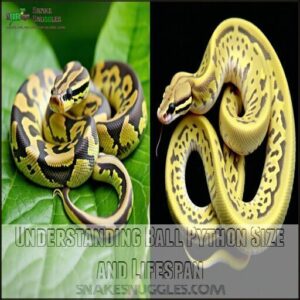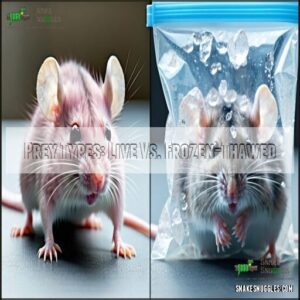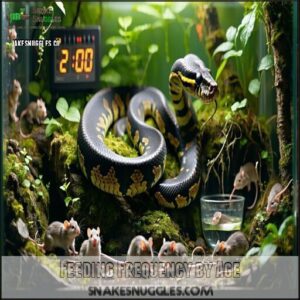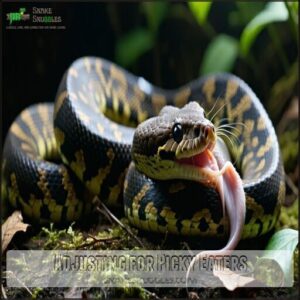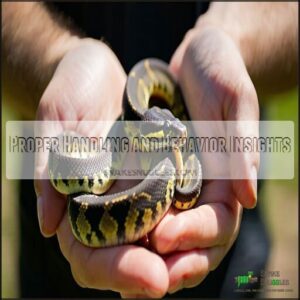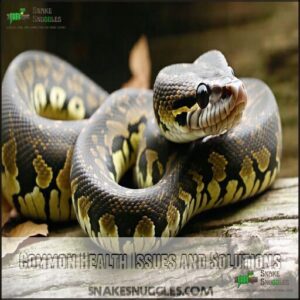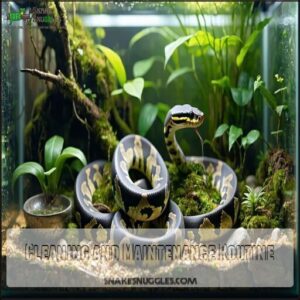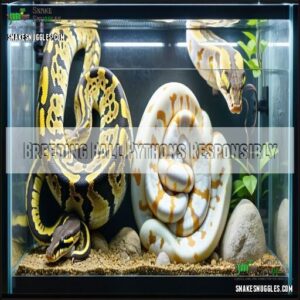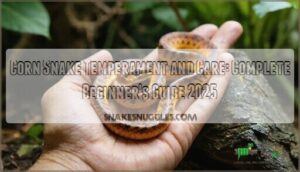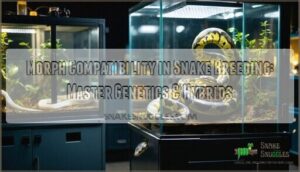This site is supported by our readers. We may earn a commission, at no cost to you, if you purchase through links.
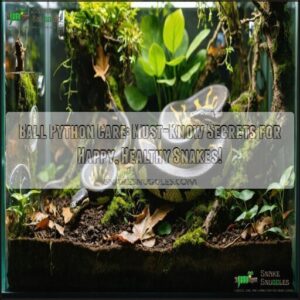 Thinking of bringing a ball python home? You’re in for a slithery adventure! These docile snakes make fantastic pets for beginners, but they’ve got specific care needs.
Thinking of bringing a ball python home? You’re in for a slithery adventure! These docile snakes make fantastic pets for beginners, but they’ve got specific care needs.
You’ll want to nail their habitat setup first: think warm, humid enclosure around 80-90°F with plenty of hiding spots. Feed them pre-killed mice or rats every 1-2 weeks, matching prey size to your snake’s girth.
Handle them gently and consistently to build trust, but watch for signs of stress like tight coiling or hissing. They’re low-maintenance compared to furry friends, but don’t skimp on research.
Curious about creating the ultimate snake sanctuary that’ll keep your scaly companion thriving?
Table Of Contents
- Key Takeaways
- Overview of Ball Pythons as Pets
- Understanding Ball Python Size and Lifespan
- Setting Up The Perfect Enclosure
- Feeding Your Ball Python
- Proper Handling and Behavior Insights
- Common Health Issues and Solutions
- Cleaning and Maintenance Routine
- Breeding Ball Pythons Responsibly
- Frequently Asked Questions (FAQs)
- How do you take care of a ball python?
- Do ball pythons need veterinary care?
- Should you buy a ball python as a pet?
- Do ball pythons need an aquarium?
- How do you handle a ball python?
- How to care for ball python for beginners?
- Are ball pythons hard to take care of?
- What not to do with a ball python?
- Do ball pythons like to be cuddled?
- What should I do if my ball python refuses to eat?
- Conclusion
Key Takeaways
- You’ll need a carefully controlled habitat with precise temperature (80-90°F) and humidity (50-60%) to keep your ball python healthy and comfortable.
- Feeding your snake requires strategic planning: choose frozen-thawed prey sized appropriately to your snake’s body width and adjust frequency based on age (weekly for juveniles, every 10-14 days for adults).
- Handling techniques matter – approach your ball python slowly, support its entire body, and limit interactions to 2-3 times weekly to build trust without causing stress.
- Ball pythons are long-term companions, potentially living 20-30 years in captivity, so you’ll need to commit to consistent care, regular veterinary check-ups, and a deep understanding of their unique reptilian needs.
Overview of Ball Pythons as Pets
If you’re searching for a low-maintenance, beginner-friendly snake that’ll become your gentle reptilian companion, ball pythons are your perfect match.
The perfect companion awaits: Ball pythons offer gentle nature, low maintenance, and a fascinating reptilian friendship.
These docile, non-venomous constrictors offer an incredible pet experience with their manageable size, calm temperament, and fascinating behaviors that’ll transform your perception of snake ownership, making them a great choice for a gentle reptilian companion.
Native Habitat and Natural Behavior
When exploring the realm of ball pythons, you’ll discover a fascinating creature native to the diverse landscapes of central and western Africa.
These remarkable reptiles thrive in grasslands and sparsely wooded regions, adapting to their unique environment with incredible survival skills.
Here’s why their natural habitat is so enchanting:
- Perfectly camouflaged for African terrain
- Masters of stealth and patience
- Experts in ambush hunting techniques
- Resilient against predatory threats
- Incredibly adaptable to changing landscapes
As nocturnal hunters, ball pythons use their environment strategically, blending seamlessly into the shadows of their wild African homes.
General Appearance and Morph Variations
After tracing their African roots, you’ll be amazed by ball python morph genetics—nature’s color palette on display.
These snakes showcase an incredible range of color morphs, from jet-black to creamy white.
Each snake’s unique appearance tells a genetic story through intricate scale types and mesmerizing patterns.
Whether you’re drawn to the electric blue-eyed leucistics or the rich caramel Mojaves, ball python morphs offer a living rainbow that’ll capture your imagination.
Why They Make Great Beginner Pets
Stepping into snake ownership? Ball pythons are the ultimate beginner’s companion. Their docile temperament and manageable size make them a perfect first reptile.
Here’s why they’re ideal for newbies:
- Low-maintenance ball python care that won’t break the bank
- Easy handling techniques for confident snake bonding
- Gentle disposition that puts nervous owners at ease
- Compact size perfect for small living spaces
Ball pythons’ docile nature is key, making them great pets. Your journey to reptile companionship starts here with ball pythons!
Understanding Ball Python Size and Lifespan
Understanding ball python size and lifespan is essential for providing the best care for your scaly companion.
You’ll want to learn about male and female size differences, how long these fascinating reptiles live in captivity, and what to expect as they grow from hatchlings to mature adults, including complete concepts about their development.
Male Vs. Female Size Differences
Wondering about ball python size differences? It’s a fascinating world of sexual dimorphism!
Female ball pythons grow faster and larger, often reaching up to 5-6 feet, while males typically max out around 3 feet.
Their size variations aren’t just cosmetic—they impact breeding dynamics and overall care.
| Ball Python | Males | Females | Comparison |
|---|---|---|---|
| Length | 2-3 feet | 4-6 feet | 2x Difference |
| Diameter | ~4 inches | Up to 6 inches | Significant Variation |
| Breeding Role | Smaller Partner | Larger Dominant | Genetic Influence |
Lifespan in Captivity Vs. Wild
If you thought size matters, wait until you hear about ball python lifespan! In the wild, these resilient reptiles typically survive 10-15 years, battling predators and harsh conditions.
But in captivity? Your scaly friend can slither through life for an impressive 20-30 years, with some record-holders reaching a jaw-dropping 47 years!
Captivity longevity depends on exceptional ball python care: consistent nutrition, stable environmental factors, and proactive health monitoring.
Your commitment transforms their genetic potential from a short wild survival story into a decades-long companionship adventure.
Sexual Maturity and Growth
These scaly companions navigate a fascinating journey from hatchling to mature snake.
Ball pythons exhibit distinct sexual dimorphism, with females typically growing larger than males.
Reaching sexual maturity takes 3-5 years, influenced by various factors.
- Growth depends on diet, genetics, and environment
- Females mature slower but ultimately reach greater sizes
- Weight milestones determine breeding readiness
- Individual ball python morphs can impact growth patterns
Setting Up The Perfect Enclosure
You’ll want to create a cozy, scientifically balanced habitat that mimics your ball python’s natural environment, ensuring their comfort and well-being.
By understanding key factors like appropriate tank sizes, temperature gradients, and humidity levels, you’ll transform a simple enclosure into a thriving sanctuary for your scaly companion.
Appropriate Tank Sizes for Different Ages
Your ball python’s tank is like a custom-fit home that grows with them. From tiny hatchlings to full-grown adults, each life stage demands a perfectly sized habitat.
- Hatchlings need cozy 10-20 gallon spaces
- Juveniles thrive in 20-30 gallon environments
- Adults require spacious 40+ gallon enclosures
- Larger snakes demand 4′ x 2′ x 2′ mansions
Upgrading tank sizes guarantees your snake’s comfort, security, and natural behavioral expression. Consider the appropriate ball python enclosure sizes for each stage.
Essential Indoor Setup Features
After selecting the right tank size, you’ll want to craft a snake sanctuary that feels like home.
Your ball python’s enclosure needs thoughtful setup with the right substrate, strategic hide box placement, and consistent environmental controls.
Creating a habitat that mimics their natural environment keeps your snake comfortable and stress-free.
For the best options, explore ball python substrate choices to promote optimal health.
| Substrate | Purpose | Recommendation |
|---|---|---|
| Aspen | Moisture Control | Excellent |
| Cypress Mulch | Humidity Retention | Very Good |
| Coconut Fiber | Natural Texture | Preferred |
| Paper Towels | Temporary | Good for Cleaning |
| Sphagnum Moss | Humidity Boost | Supplemental Use |
The table provides a comparison of different substrates, including their purpose and recommendation, to help you make an informed decision for your ball python’s enclosure setup and overall well-being.
Ideal Temperature and Humidity Levels
Want to dial in the perfect habitat for your ball python?
Master the temperature gradient with a warm basking spot (88-95°F) and cool zone (75-80°F).
Keep a steady 50-60% humidity, bumping to 80% during shedding.
Use a reliable hygrometer to track humidity levels and a thermostat for precise temperature control, ensuring your scaly friend thrives in comfort.
Consider using a reptile thermostat system for ideal environmental control.
Feeding Your Ball Python
Feeding your ball python properly is key to its health and happiness.
You’ll need to provide appropriately sized prey like mice or rats, with a schedule that matches your snake’s age and growth stage, which is a complete concept in snake care.
Prey Types: Live Vs. Frozen-Thawed
- Live Prey Risks: Injuries and stress to your snake.
- Frozen-Thawed Benefits: Safer and easier to store.
- Prey Size Matters: Match prey to your snake’s widest point.
- Feeding Techniques: Warm frozen prey to mimic live movement.
- Prey Storage Methods: Keep frozen prey in airtight bags.
Frozen-thawed options guarantee safety and simplify your ball python diet.
Feeding Frequency by Age
How often should you feed your slithery friend?
Hatchlings under 300 grams need weekly meals of pinky mice or fuzzy rats, carefully sized to 10-15% of their body weight.
As your baby ball python grows, adjust the feeding schedule—juveniles typically eat every week, while adults can go 10-14 days between meals.
Stay consistent, watch their weight, and remember: a well-fed python is a happy python, and this balance is key to their health, making weekly meals an essential part of their care.
Adjusting for Picky Eaters
Struggling with a finicky ball python at mealtime?
When feeding frequency slows, try these game-changing strategies.
Warm your frozen-thawed prey to body temperature and gently rub them with attractive scent trails.
Experiment with prey sizes and types, matching your snake’s preferences.
Dim the lights during feeding to create a more comfortable hunting environment.
If refusals persist, consult a reptile veterinarian to rule out underlying health issues.
Proper Handling and Behavior Insights
When you bring a ball python home, you’ll need to master the art of gentle, consistent handling to build trust and reduce stress for your new scaly companion.
By understanding their unique temperament and body language, you’ll create a safe and comfortable environment that helps your snake feel secure and develop a positive relationship with you.
Safe and Gentle Handling Tips
Your ball python’s handling success hinges on mastering gentle techniques. Approach slowly and confidently Support their entire body weight * Learn their unique stress signals
Gentle hands, patient heart: Your ball python’s trust is earned through calm, confident connection.
When interacting with your scaly friend, remember: snakes aren’t cuddle buddies. Each python has a personality, so read their body language carefully. Patience transforms handling from a nerve-wracking experience into a smooth, trust-building connection that keeps both you and your python calm and comfortable.
Understanding Ball Python Temperaments
Your new ball python might seem shy at first, but don’t worry! These docile creatures naturally curl up when feeling uncertain.
By consistently and gently handling your snake, you’ll help them build confidence. Pay attention to their stress indicators like defensive ball-coiling.
With patience, your snake will transform from a timid companion to a curious, relaxed friend who trusts your presence. Understanding the influence of genetics can also help to create a relaxed environment.
Avoiding Handling During Specific Times
Your ball python isn’t a cuddly companion—some moments demand hands-off respect.
Post-feeding, let digestion happen undisturbed. During shedding periods, your snake’s sensitive skin needs zero interference.
Watch for stress indicators like defensive coiling or excessive hiding, which signal it’s time to step back.
Breeding season and illness also demand minimal handling to keep your slithery friend calm and healthy, and it’s crucial to recognize these periods for the well-being of your pet, ensuring a healthy environment.
Common Health Issues and Solutions
Every ball python owner needs to know the warning signs of potential health problems before they become serious.
Your snake’s well-being depends on recognizing respiratory infections, scale rot, and other common issues that can impact its overall health and longevity.
Respiratory Infections and Scale Rot
Your ball python’s health hinges on understanding two sneaky culprits: respiratory infections and scale rot. These silent threats can derail your snake’s well-being faster than you’d think.
- Respiratory Infections Causes:
- Scale Rot Symptoms:
- Treatment Options:
- Prevention Strategies:
Respiratory infections emerge when temperatures dip or humidity soars, while scale rot creeps in through damp, dirty environments.
Wheezing, nasal discharge, and discolored scales scream "vet time!" Keep your habitat pristine, monitor conditions closely, and act quickly.
Your scaly friend’s health depends on your vigilance.
Stuck Sheds and Their Remedies
Shedding snake skin can turn into a tricky reptile challenge, especially for ball python owners.
Low humidity often triggers incomplete sheds, leaving patches of old skin clinging stubbornly to your scaled friend.
To combat this, boost enclosure moisture and consider gentle warm water soaks.
| Shedding Issue | Solution | Extra Care |
|---|---|---|
| Partial Shed | Increase Humidity | Moisturizing Aids |
| Stuck Eye Caps | Warm Soaks | Careful Removal |
| Full Body Shed | Humidity Control | Shedding Assistance |
| Tail Tip Retention | Moisture Adjustment | Post-Shed Inspection |
The table outlines specific shedding issues and their corresponding solutions, along with any extra care that may be required to ensure a healthy shed.
Signs Your Snake Needs a Vet
How quickly can you spot health red flags in your ball python? Your keen eye might save its life.
Watch for these critical warning signs:
- Respiratory issues like wheezing or bubbles
- Unusual scale discoloration or persistent shedding problems
- Dramatic weight changes or reduced appetite
These symptoms could signal serious ball python health concerns. When in doubt, consult a reptile veterinarian specializing in snake diseases—early intervention prevents long-term complications, which is critical for the snake’s health.
Cleaning and Maintenance Routine
Maintaining a clean and safe environment is essential for your ball python’s health and happiness.
You’ll need to establish a consistent cleaning routine that includes daily spot cleaning, weekly substrate replacement, and monthly thorough disinfection to prevent potential health issues.
This routine will guarantee your snake thrives in a pristine habitat.
Daily and Weekly Cleaning Practices
Your ball python’s health hinges on a thorough cleaning routine. Each day, perform spot cleaning by removing waste from the substrate and renewing the water dish.
Replace soiled areas promptly to maintain a hygienic environment.
Weekly, swap out cleaning tools and inspect the enclosure for any signs of contamination. Consistent maintenance prevents bacterial growth and keeps your slithery companion comfortable and thriving.
Disinfection Tips for Enclosure Safety
After scrubbing surfaces clean, it’s time to disinfect your ball python’s kingdom.
Use reptile-safe cleaners that kill germs without harming your scaly friend. Diluted bleach solutions work wonders when mixed correctly—about 1 part bleach to 10 parts water.
Always wear gloves, make certain proper ventilation, and let disinfectant sit for ten minutes before rinsing thoroughly.
Quarantine new decor and clean regularly to prevent disease spread. Your snake’s health depends on a spotless, germ-free home.
For effective cleaning, consider using F10SC disinfectant solutions to guarantee a safe environment.
Maintaining a Healthy Living Space
After sanitizing your ball python’s home, maintaining a pristine habitat becomes your next mission.
Think of the enclosure as your snake’s personal sanctuary—a space that demands fastidious care.
Here’s your game plan:
- Spot-clean daily, removing waste like a detective on a mission.
- Refresh water consistently to prevent bacterial buildup.
- Deep-clean weekly with reptile-safe disinfectants.
- Monitor temperature gradient and humidity religiously.
- Guarantee proper ventilation for superior air quality.
Your snake’s health depends on this routine.
Breeding Ball Pythons Responsibly
If you’re passionate about expanding your ball python collection, you’ll need to understand the scientific and ethical aspects of responsible breeding.
Proper breeding requires careful consideration of genetic traits, snake health, and the potential risks of overbreeding, ensuring you’re contributing positively to the ball python community, with a focus on responsible breeding and genetic traits.
Size and Weight Requirements for Breeding
Breeding ball pythons isn’t a race—it’s a delicate science.
Female ball pythons need to hit the 1,500-gram weight mark, while males typically mature between 500-700 grams.
Your patience is key. Monitor their growth, feeding consistency, and overall health before considering breeding.
Weight thresholds aren’t just numbers; they’re essential indicators of reproductive readiness.
Risks of Overbreeding in Captivity
Every responsible breeder knows the dark side of ball python breeding: genetic diversity rapidly declines with rampant overbreeding.
You’ll risk compromising animal welfare and propagating health problems when market saturation leads to unethical practices.
Captive-bred morphs demand careful management to prevent genetic weakening, ensuring the long-term survival and well-being of these remarkable reptiles, which is crucial for maintaining animal welfare and preventing health problems.
Understanding Genetic Morph Variations
Ball python morphs are a genetic rainbow of possibilities! You’ll discover fascinating color patterns like lavender, yellow, and beyond by understanding morph genetics. Smart gene pairing reveals nature’s artistic side.
- Your snake can become a living masterpiece
- Genetic diversity tells a unique story
- Color mutations spark curiosity
- Each morph brings unexpected wonder
Responsible breeding transforms Python regius into a living canvas of genetic artistry. This process showcases the artistic side of nature, making each snake a unique creation.
Frequently Asked Questions (FAQs)
How do you take care of a ball python?
Provide a warm habitat with precise temperature and humidity.
Feed pre-killed rodents sized to your snake’s girth, handle gently 2-3 times weekly.
Create secure hiding spaces to keep your ball python healthy and content.
Do ball pythons need veterinary care?
An ounce of prevention is worth a pound of cure.
You’ll want an exotic pet veterinarian who specializes in reptiles for annual check-ups, addressing potential health issues like respiratory infections, parasites, and skin conditions early on to prevent a pound of cure.
Should you buy a ball python as a pet?
You’ll love a ball python if you’re patient, enjoy low-maintenance pets, and can handle occasional feeding challenges.
They’re gentle, quiet, and perfect for first-time reptile owners who don’t mind periodic feeding reluctance.
Do ball pythons need an aquarium?
Seriously stellar serpent setups aren’t just aquariums! You’ll want a specialized terrarium designed for reptiles, with proper heat, humidity controls, and hiding spots that mimic your python’s natural habitat.
How do you handle a ball python?
Gently support your ball python’s body, avoiding sudden movements.
Handle slowly and confidently, letting the snake feel secure.
Wash hands before and after, approach calmly, and limit handling to 2-3 times weekly for stress-free interaction.
How to care for ball python for beginners?
Ever wondered how to turn your ball python into a happy, healthy companion?
Provide a secure habitat, maintain proper temperature and humidity, feed pre-killed prey, handle gently, and learn your snake’s unique personality for a rewarding experience.
Are ball pythons hard to take care of?
Ball pythons aren’t hard to care for if you’re prepared.
They’re docile, low-maintenance pets that need consistent temperatures, proper feeding, and gentle handling.
With basic research and commitment, you’ll find them surprisingly manageable for first-time snake owners.
What not to do with a ball python?
Don’t handle your snake during shedding, right after feeding, or when stressed.
Avoid sudden movements, loud noises, and extreme temperatures.
Never house multiple pythons together, and always wash your hands before and after handling, to prevent any potential risks, especially when dealing with sudden movements and extreme temperatures.
Do ball pythons like to be cuddled?
Like a stone statue, your ball python won’t melt into cuddles.
These solitary serpents prefer minimal handling and calm interactions.
They’re not touchy-feely companions, so respect their space and enjoy their presence without expecting warm, fuzzy embraces.
What should I do if my ball python refuses to eat?
When your snake refuses food, don’t panic.
Check the environment’s temperature and humidity. Verify proper prey size, try different prey types.
If the hunger strike persists beyond a few weeks, consult a veterinarian to address the issue, focusing on the environment’s temperature and other potential causes.
Conclusion
Look before you leap into ball python pet care! Your scaly companion isn’t just another pet—it’s a commitment to understanding complex reptilian needs.
Mastering ball python pet care means creating a thriving environment through consistent research, proper habitat design, and dedicated attention.
By investing time in learning their unique behaviors and requirements, you’ll transform your snake ownership from challenging to rewarding.
Embrace this fascinating journey with knowledge, patience, and genuine care.
- https://bioone.org/journals/journal-of-herpetology/volume-39/issue-2/111-02N/Sex-Differences-in-Body-Size-and-Ectoparasite-Load-in-the/10.1670/111-02N.short
- https://www.sciencedirect.com/science/article/abs/pii/016815919390030S
- https://mbio.asm.org/content/5/5/e01484-14.short
- https://www.lovetoknow.com/life/lifestyle/guide-adobe-printables
- https://petkeen.com/ball-python-morphs/


